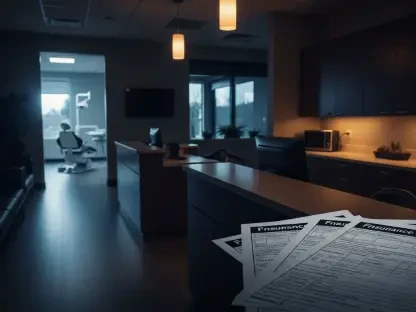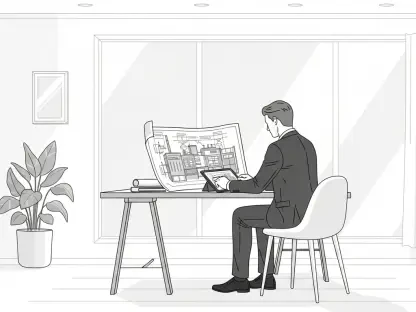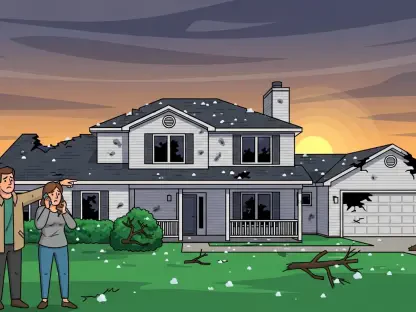In the summer of 2023, a devastating wind and hail storm tore through Florissant, Missouri, leaving Paddock Hills Shopping Center—a commercial property owned by Paddock Equity Investors, LLC—in ruins with damages that sparked a fierce legal battle. This single-story structure, insured by Auto-Owners Insurance Company, sustained what Paddock claims was over $2 million in destruction to its roofing, HVAC systems, and other critical components. Yet, the insurer’s response was a repair estimate of just over $15,000 initially, later revised to around $145,000, falling drastically short of Paddock’s assessment. This glaring disparity led to a federal lawsuit filed in September of this year in the Eastern District of Missouri, alleging breach of contract and inadequate claim handling. The case not only highlights a significant financial disagreement but also exposes deeper systemic issues within the insurance industry about how storm damage claims are evaluated and resolved, raising questions about fairness and transparency.
Unpacking the Storm’s Aftermath
The storm that struck on July 17, 2023, was unrelenting, battering Paddock Hills Shopping Center with fierce winds and hail that reportedly damaged its flat roofing systems, asphalt shingles, metal flashings, gutters, and HVAC units. Under the terms of the policy with Auto-Owners, such direct physical losses from weather events were covered, subject to specific conditions and exclusions. However, when Paddock notified the insurer of the damage a month later, the response was far from what was anticipated. Auto-Owners deployed adjusters and third-party experts who concluded that much of the destruction was due to pre-existing wear and tear, not the storm itself. Their initial repair estimate amounted to a mere $15,722.82, with a net value even lower after depreciation, and ultimately, no payment was issued as it fell below the policy’s substantial windstorm and hail deductible. This left Paddock grappling with significant losses and no immediate financial relief from the insurer.
Determined to challenge this assessment, Paddock commissioned independent evaluations to get a clearer picture of the damage. Experts from RestoreMasters, LLC, estimated repairs at a staggering $2,045,867.60, while Wohlscheid Civil Engineering identified extensive wind and hail impacts, including moisture intrusion and the need for complete roof replacement. These findings painted a grim reality of systemic damage far beyond the isolated issues Auto-Owners acknowledged. The vast chasm between the insurer’s minimal estimate and Paddock’s comprehensive reports became the crux of the dispute, fueling allegations that the insurer failed to fully recognize the storm’s true toll. This situation underscores the challenges property owners face when insurer assessments appear to minimize losses, often leaving claimants to bear the burden of proving their case through costly independent analyses and pushing the matter toward legal confrontation.
The Divide in Damage Evaluations
At the heart of this conflict lies a profound discrepancy in how the storm damage was quantified by the involved parties. Auto-Owners relied on reports from Donan Forensic Engineering, which repeatedly downplayed the extent of hail damage to critical areas like the roof membrane, focusing instead on limited repairs to shingles and gutters. Their supplemental reports, even after acknowledging some HVAC damage, maintained that much of the property’s condition stemmed from pre-existing issues, not covered under the policy. This narrow scope of evaluation resulted in a revised estimate in June of this year of $145,580.80, with an actual cash value of just $66,254.69 after depreciation. Such figures stand in stark contrast to the over $2 million in repairs Paddock’s experts deemed necessary, revealing a fundamental disagreement on the severity and cause of the destruction that questions the consistency of forensic assessments in insurance claims.
Adding to the complexity is the nature of storm damage itself, which often involves overlapping effects from wind, hail, and water intrusion, especially on properties with diverse materials like those at Paddock Hills. Determining what falls under policy coverage versus what constitutes wear and tear or prior damage is rarely straightforward. The conflicting conclusions between Donan’s limited findings and the comprehensive reports from Paddock’s hired professionals, such as Wohlscheid Civil Engineering, illustrate how subjective expert judgments can be. While one side saw isolated, fixable issues, the other identified widespread, systemic failures requiring extensive intervention. This divide not only fuels the current lawsuit but also reflects a broader industry challenge: ensuring that damage assessments are thorough, transparent, and aligned with the realities of complex property losses, rather than leaving policyholders feeling shortchanged.
Challenges in Claim Processing and Response
Paddock’s grievances extend beyond mere numbers to the very process by which Auto-Owners handled the claim, alleging significant delays and an inadequate investigation that compounded their financial strain. According to the lawsuit, the insurer failed to conduct a detailed examination, neglecting critical tests for moisture or thermal damage that could have revealed the full extent of the storm’s impact. Reports from independent entities like HVACi, which found nearly half of the property’s HVAC units damaged by hail, were seemingly underweighted in Auto-Owners’ final assessments. This perceived dismissal of evidence, coupled with a prolonged timeline before even a revised estimate was offered, left Paddock with little choice but to fund their own expert evaluations and, ultimately, pursue legal action to recover what they believe is rightfully owed under the policy terms.
This case also mirrors a troubling pattern in the insurance sector where policyholders often encounter barriers in the form of slow responses or restrictive interpretations of coverage. When insurers cite high deductibles or pre-existing conditions to justify minimal payouts, trust can quickly erode, pushing disputes into the courtroom. Paddock’s experience highlights how the lack of prompt, thorough claim handling can exacerbate a property owner’s burden, turning a natural disaster into a prolonged battle for compensation. The frustration of dealing with what feels like an unresponsive or dismissive process often leaves claimants with the impression that their losses are not being taken seriously. Such scenarios point to a pressing need for insurers to prioritize clear communication and comprehensive investigations to prevent disputes from escalating to litigation, preserving relationships with policyholders.
Broader Implications for Insurance Practices
The lawsuit filed by Paddock Equity Investors against Auto-Owners brings to light systemic issues that plague commercial property insurance claims across the industry. Disparities in damage assessments, as seen with the nearly $2 million gap between estimates, are not uncommon and often stem from differing methodologies or scopes of analysis used by insurer-hired versus independent experts. The reliance on third-party adjusters and forensic engineers, while intended to provide objectivity, can sometimes lead to inconsistent conclusions if the scope of their reviews is limited or if critical aspects of damage, like hidden moisture intrusion, are overlooked. This case serves as a stark example of how such inconsistencies can derail the claims process, leaving policyholders to navigate a maze of conflicting reports and undervalued losses in their quest for fair resolution.
Looking beyond this specific dispute, there is a clear trend of growing tension between insurers and commercial policyholders over how large property losses are handled. Many in the industry note that ambiguous policy language and the inherent challenges of quantifying complex damages contribute to frequent disagreements. Insurers often lean on exclusions or deductibles to limit payouts, while claimants argue these measures fail to account for the full scope of covered events. Addressing these challenges requires a shift toward greater transparency in claim evaluations and more standardized approaches to damage assessment. Until such reforms are prioritized, disputes like the one involving Paddock Hills Shopping Center are likely to persist, underscoring the urgency for improved practices that bridge the gap between insurer obligations and policyholder expectations.
Reflecting on a Path Forward
Looking back, the legal battle between Paddock Equity Investors and Auto-Owners Insurance unfolded as a poignant reminder of the vulnerabilities commercial property owners face after natural disasters. The storm of July 2023 left a lasting mark on Paddock Hills Shopping Center, but it was the subsequent clash over compensation—with estimates differing by millions—that truly exposed the fault lines in the insurance claims process. The allegations of undervaluation and poor claim handling by Auto-Owners painted a picture of frustration and financial strain for Paddock, driving them to seek justice through the courts.
Moving forward, this case should prompt insurers to reevaluate how storm damage claims are approached, emphasizing thorough, timely investigations and open dialogue with policyholders to prevent such disputes from escalating. Establishing clearer guidelines for damage assessments and ensuring that all relevant evidence is considered could help rebuild trust. As the lawsuit progresses, it stands as a call to action for the industry to address these systemic shortcomings, paving the way for fairer resolutions in future claims and reducing the likelihood of costly legal battles.









